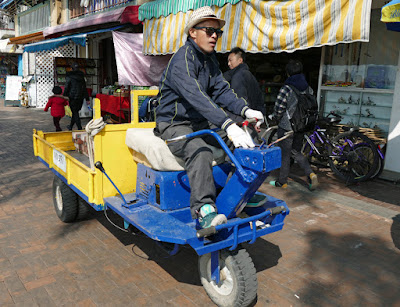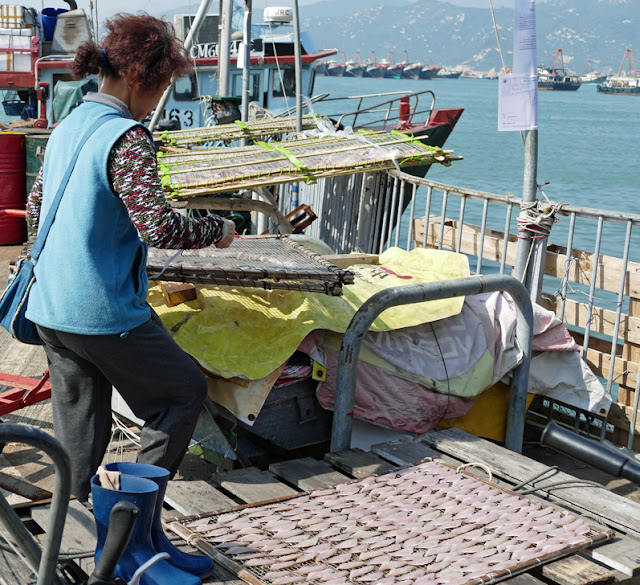We took the 'ordinary' triple-deck ferry to
Cheung Chau Island today for a seafood lunch. Cheung Chau is 14 Km
southwest of Hong Kong Island and about 50 minutes ferry time away –
and the ordinary adult one-way fare is a bargain HK$13.20 (just over
£1 or US$1.50).
It was blowing a gusty force 4 as we set off and there were a few whitecaps although the sun shone and temperatures were a modest 12 or 13 Celsius (low 50s Fahrenheit). We passed the usual ferries and assorted small craft like the couple below.

Then we picked up speed, leaving the narrow confines of Victoria Harbour and entering the Western Approaches to the harbour.
Ahead we could see a line of ships against the horizon, larger ships that were unable to enter the harbour proper because of their deep draught, or which were anchored awaiting loading/unloading by smaller ships like the lighter barges.
Curiously, off to the right there were what looked like dozens of lighters and tugs sheltering under the Tsing Ma Bridge, like chickens crowded under a hen. I guess they were waiting for business from the fleet of anchored ships. The Bridge is impressive, it was the second longest suspension bridge in the world when it was opened 18 years ago (now it's just the ninth-longest - but still quite a sight!).
Now we were among the anchored vessels; container ships, tankers, bulk and dangerous cargo ships.
Similarly, a smaller ship was unloading cargo from an anchored ship. It looks like it was liquid, perhaps petroleum, or gas, or a dangerous cargo that was safer transferred away from habitation.
Finally, after about 50 minutes we came to Cheung Chau. There were several boats anchored at the approaches to the harbour - including the inevitable police boat, this time a large one suitable for inter-island all-weather activity.
But, as might be expected, fishing vessels predominated, from high-prowed ocean-going trawlers to chunky local vessels. The harbour was crammed with vessels, many anchored together in rows. The island's economy is largely based on fishing and related business; ship-building, provisioning, fish curing and sale of fish products – although it has successfully branched out into tourism in recent years, particularly through the provision of holiday flats. The island was originally a refuge for pirates, that trade has fallen into disuse now...
We left the good ship Xin Chau moored to the harbour wall and went exploring.
The promenade or Praya facing the harbour is lined with small shops, restaurants, places renting holiday flats - and bicycles.
As far as the eye could see, there were dozens - possibly hundreds - of bicycles.
There are even mini vehicles for the emergency services, small fire engines, miniature ambulances and tiny police cars – Noddy would be pleased!
Next stop - lunch! We spent quite a while reviewing the menus outside the restaurants, inspecting the tanks of fresh fish and crustaceans, and then selected a set menu that contained most of the goodies we were looking for, and supplemented it with a couple of extra dishes.
In sum, we ordered
scallops, razor clams, abalone with Chinese lettuce, fried salmon,
geoduck, lobster and crab dishes – and a separate dish of
salty-fish rice from a traditional restaurant.
Then, we set through the narrow lanes, past small higgledy-piggedly houses and shops built into the side of the hill overlooking the harbour. Up and up we climbed at an angle of maybe forty-five degrees or more following the cement tracks that serve for roadways until we reached the summit of the hill and saw glimpses of the sparkling blue South China Sea spread all around us.
We passed
what looked like an abandoned squatter camp, the tiny shacks built
from driftwood, tree branches and spare scraps of lumber. It was
clearly an official camp because there was a board with metal
postboxes numbered for each houses. One small garden had a papaya
tree growing in it with bunches of fruit.
On we went, and round a corner was the perfect view. Large expensive villas on a headland overlooked the sparking South China Sea. Beautiful...
A little footsore, we headed down the hill to the harbour and the ferry home.
Time for one last bit of nauticalia on the way back. I tried to spot the different Cardinal navigation buoys...
 |
| EAST |
 |
| NORTH |
 |
| SOUTH |
 |
| WEST |
 |
| and, of course, SAFE WATER |































No comments:
Post a Comment